by Tara Mitchell
A Need for Change
Wood-inhabiting fungi are at the core of forests’ ability to regenerate and provide habitat for wildlife. They are the primary agents of wood decomposition and are the only species that can break down lignin, the tough material that gives trees and vascular plants rigidity and structural strength. By breaking down wood and woody debris, they help replenish soils and release the nutrients accumulated during a tree’s life, making those nutrients available for uptake by plants and mycorrhizae, soil dwelling fungi that have a symbiotic relationship to plants. The dead wood that decomposers leave behind becomes habitat for countless organisms, from earth dwelling millipedes and springtails to woodpeckers and owls that nest in the cavities of dead and decaying trees.
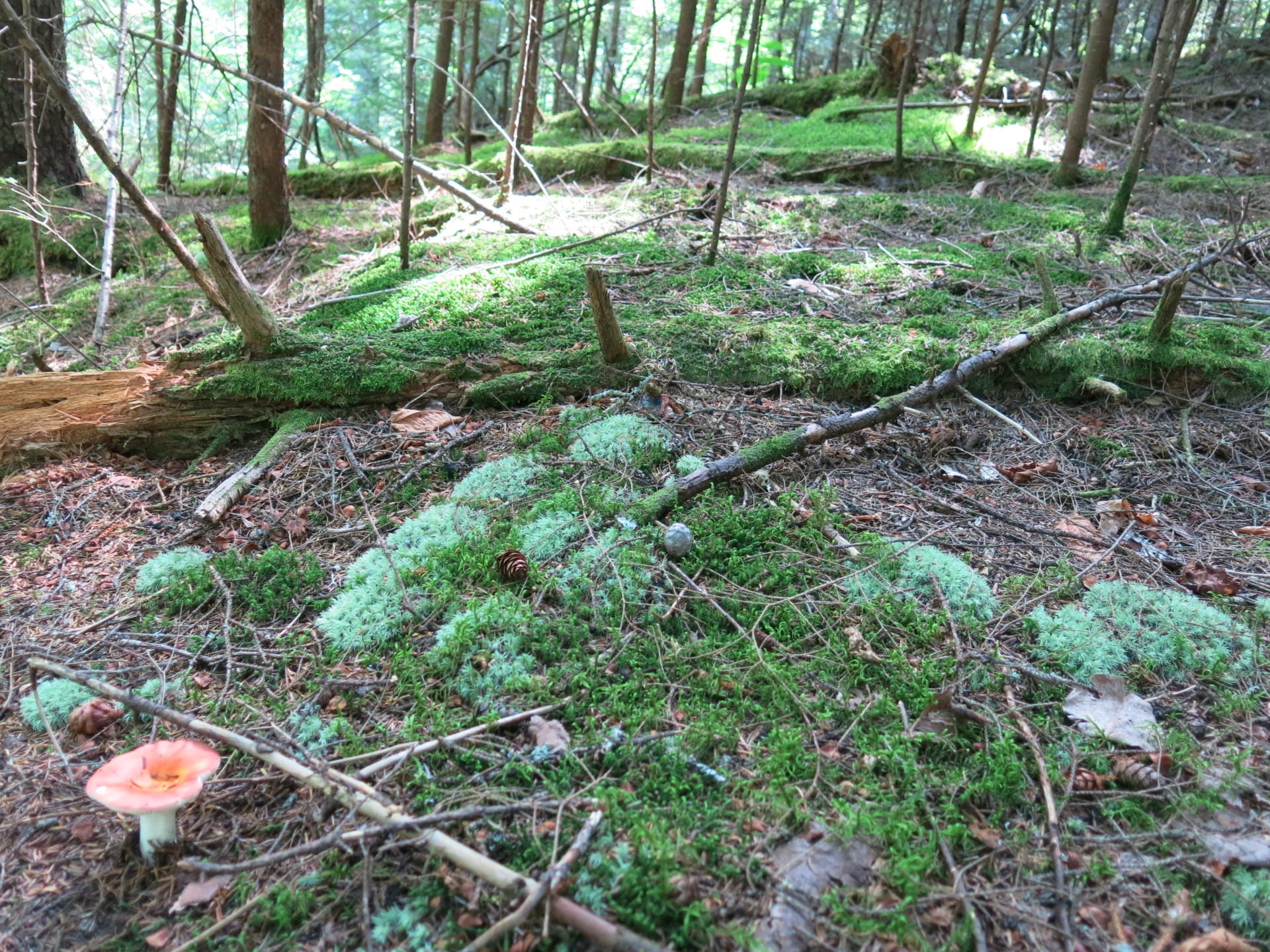
Wood decomposers create substrate and habitat for countless species in the forest, including mosses, lichen, and soil dwelling mycorrhizal fungi, such as the Russula seen here.
Yet, in the realm of the managed landscape, we focus solely on the destructive aspects of decomposers. We associate them only with the end of life, with death and decay. We refer to them as “diseases” and “pathogenic,” relegating them to the Kingdom of Pests. The typical, traditional landscape is, with little exception, expansive lawn and a handful of “ornamental” or “shade” trees. Such sparsely vegetated land provides next to no habitat for fungi, never mind for any organism, and no use for them. The standard “maintenance” practices of mowing, blowing, pruning, and vacuuming eliminates all dead plant matter and the decomposers along with it. Without that organic matter and the associated fungi, plants in these sterile, manicured lands are dependent upon costly applications of fertilizers and irrigation to sustain them.
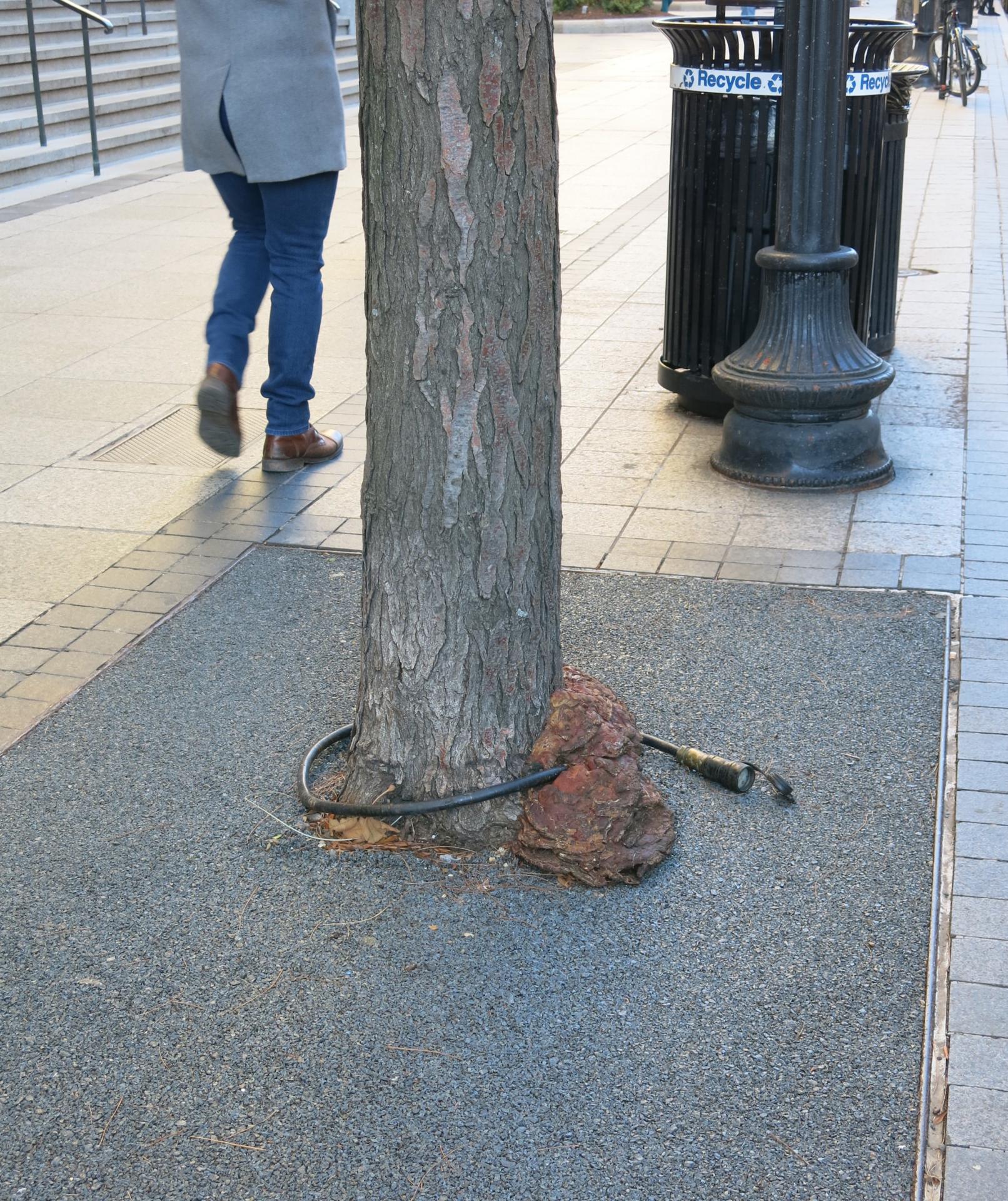
Too often trees are planted in places and in conditions that don’t allow for healthy growth. This leaves them susceptible to parasitic fungi that feed on injured or weakened trees.
On the larger scale, with increases in invasive species, declining populations of native insects that support native vegetation, the complications of climate change, the rapid and relentless spread of development (and the manicured landscapes that come with it), natural lands are being altered and diminished. As result, they are losing the capacity to provide necessary functions, such as of water management, soil preservation, and habitat for wildlife. If we can’t preserve these lands, it becomes increasingly important that we provide those functions in the converted, managed landscape. Toward that end, we need to stop turning self-sustaining natural systems into land dependent on irrigation, fertilizers, pesticides, and annual mulching.
We have been conditioned to believe that the traditional aesthetic and all the inputs to support it are necessary. But if we take the time to look at natural systems, evidence to the contrary is all around us. If we simply take a walk in the forest, the function and value of wood-inhabiting fungi and the dead and decaying wood they leave behind is readily visible.
A Brief Look at Who’s Who in the World of Wood
The mushrooms that we see growing on wood or at the base of trees are the fruiting body of a fungus. The body of the fungus itself is a mycelial mat that consists of a network of thin white stands (hyphae) and lives hidden in the moist darkness of wood or soil. To get nutrients and sugars, wood-inhabiting fungi excrete enzymes that chemically break down cellulose, hemicellulose, and lignin, the components of wood.
Most wood decomposers are saprophytic, feeding on dead wood. However, some early colonizers are parasitic, targeting living trees, usually those that are weak or that have been injured. Many of these early colonizers produce the hard, perennial conks or bracket mushrooms we see growing on trees or stumps. Others, including some choice edibles such as oyster mushrooms and the colorful chicken mushroom (Laetiporus cinncinatus), produce soft-bodied mushrooms.

Different fungi target different tree species and different parts of the tree and the wood. Fomitopsis pinicola (red belted polypore), a very common bracket mushroom, targets cellulose and is found on the trunks of conifers; Laetiporus cinncinatus, (chicken of the woods), an edible mushroom, is found at the base of oak trees and targets the roots and butt of trees; Trichaptum biforme (violet-toothed polypore), commonly found on hardwood logs and stumps, breaks down both lignin and cellulose.
Wood-inhabitants occupy every layer of space and time in the world of wood. Different species target different types of trees (hardwood, conifer, or both) and can be found on different parts of the tree. For instance, mushrooms found on the trunks of trees are likely feeding on the heartwood or sapwood. Those, like Laetiporus cinncinatus, found at the base of oak trees or on soil close to the trunk, are likely feeding on the butt and roots of the tree. Other fungi are secondary feeders, feeding only on decayed wood or on twigs and leaves.

Some forest decomposers of woody debris can also be found in the urban landscapes, such as Agaricus arvensis (horse mushroom), which is a choice edible; Crucibulum laeve (common bird’s nest); and Coprinus atramentarius (ink caps).
Different fungi also feed on different layers and components of the wood. Some feed on sapwood, the outer living wood, while others consume heartwood, the hard, dead wood in the center of the tree which provides structural support. Most decomposers produce enzymes that break down lignin or both lignin and cellulose, creating a soft, fibrous white rot. With white rot, the remaining cellulose (until it is broken down) is pale or bleached looking due to the loss of the dark lignin. Fungi that feed on cellulose and hemi-cellulose leave behind the oxidized lignin creating brown rot, which is dry and brittle. Brown rot decomposers are fewer in number and are usually found on conifers.
Making Way for Fungi: A Systems-Based Approach
Wood-inhabitants have value in the landscape only as part of larger systems in which they can function to transform dead wood into life sustaining elements. Taking advantage of the benefits that wood-inhabitants can provide therefore requires a systems-based approach to landscaping, rather than the traditional, simple use of trees and shrubs as singular, ornamental elements in the lawn. Designing to allow for natural processes along with (not instead of!) aesthetics will allow wood decomposers a place in the land. This means a more naturalized landscape that replicates the conditions of the forest and that allows for a bit of mess and imperfection.
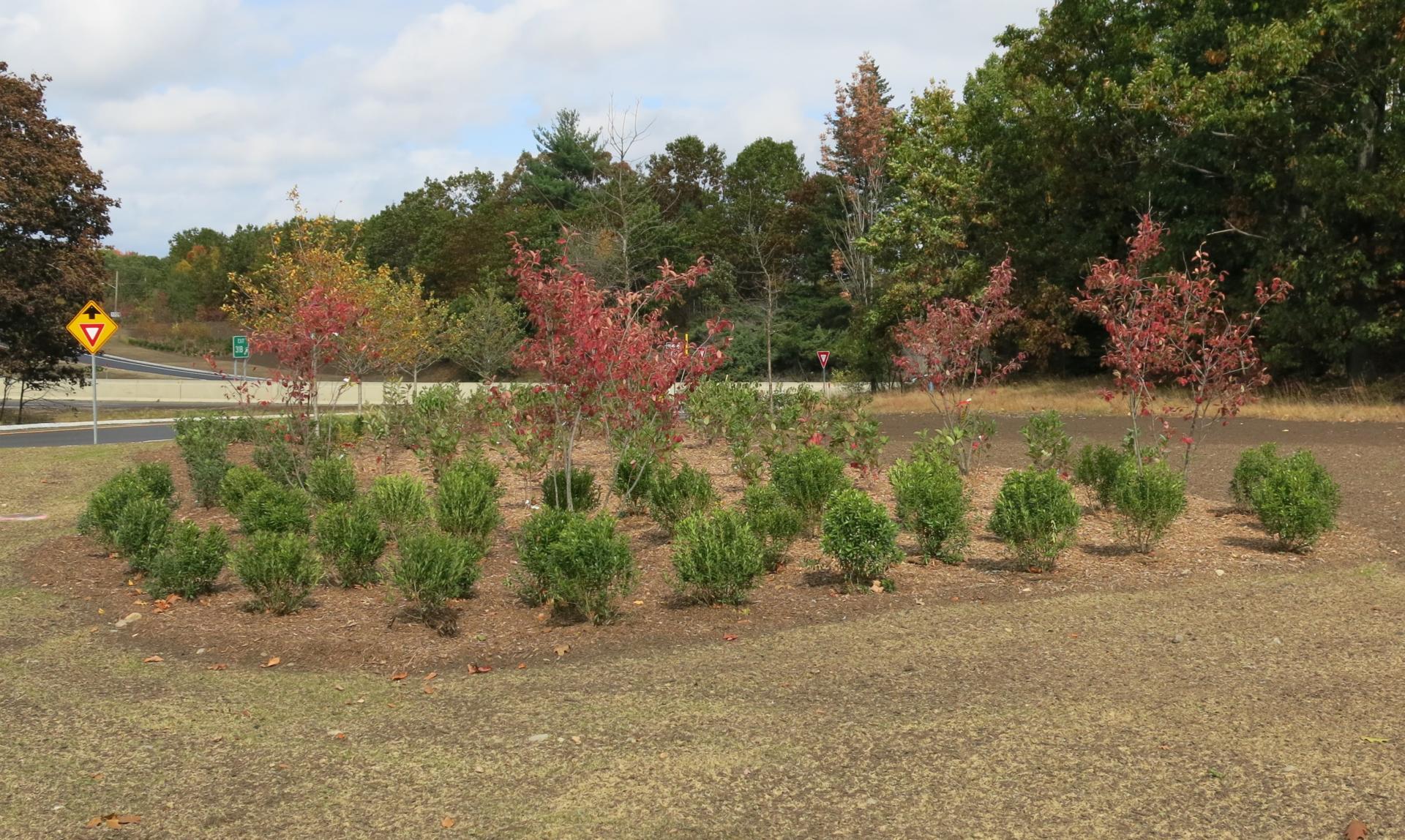
MassDOT Roadside Planting. Grouping and mixing species allows vegetation to work as a system in which wood-inhabiting fungi provide the function of recycling nutrients, contributing to moisture management, and creating habitat.
For instance, instead of planting a few trees 25 feet apart in a lawn delineated by a hedge of one species of shrub, group plants to create small, more densely mixed “woodland” areas. Working as a system, shrubs shade and protect soil and tree roots, trees provide shade for shrubs, and the dead leaves and woody debris of both provide moisture and food to support both mycorrhizal and wood-inhabiting fungi. Decomposers, in turn, in consuming that woody material, transform it into elements that sustain plants and allow for new growth. In this self-sustaining system, the need for fertilizers, irrigation, pesticides, and mulches (money and work) is eliminated or reduced. Whether designing for screening or beauty, the invisible organisms sustain the life of the entire system.
Tapping the Potential
The activity of wood-inhabiting fungi is largely invisible. But because wood is above ground and decomposition is slow, evidence of their work is spread throughout the forest and the functional benefits they can bring to the managed landscape are visible.
Soil and Water Management. Decomposition of wood replenishes soil. Brown rot, comprised of lignin, is resistant to decay and thus especially important in contributing to soil. Allowing dead trees and dead wood to remain and decompose in the managed landscape will contribute to the renewal of soil.
Throughout the forest, decaying wood in the form of logs and stumps support the forest by contributing to water management. The fibrous, porous material of white rot acts like a sponge, absorbing water and holding moisture. Over time, that moisture is slowly released, helping to maintain forest humidity during drought. Mosses and lichen, seeking a moist, stable substrate, colonize the surface of stumps and logs. These species retain water for their own survival, and thus they add to the moisture holding capacity of dead wood. Dead roots and wood buried in soil provide a source of moisture for plant roots and mycorrhizae as well as for other soil dwelling organisms.
On slopes and stream banks, fallen trees and logs provide physical barriers to the flow of water, diverting it and slowing velocity. As the decomposers break down the wood, they release nutrients and increase the moisture-holding capacity, supporting the growth of mosses and plants that stabilize the banks.
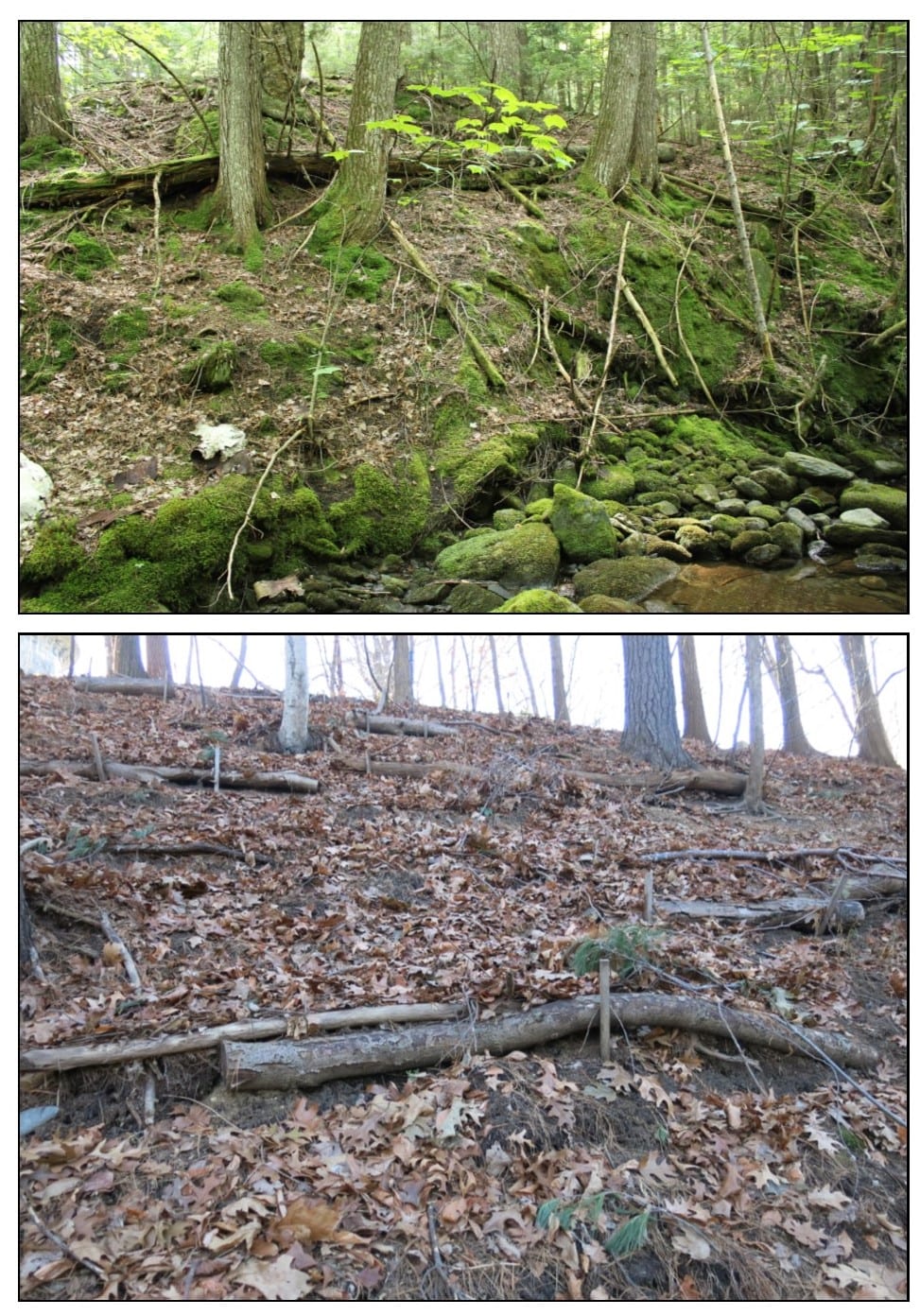
Replicating natural systems such as a forested stream bank (above), dead wood can be used to stabilize slopes and help sustain restoration plantings. Below: Slope restoration at Mount Auburn Cemetery, Cambridge, MA. Work by Groundscapes Express.
Similarly, in the managed landscape, dead wood can be used on slopes to help stabilize soil and support new plantings. Logs and stumps can be left in place or incorporated aesthetically into the landscape. Wood and woody material can also be buried directly into garden soil where the decaying wood retains moisture and encourages beneficial fungal activity. Whether experiencing inundation or drought, the function of absorbing, retaining, and gradually releasing moisture protects soil and ensures healthy growth of plants.
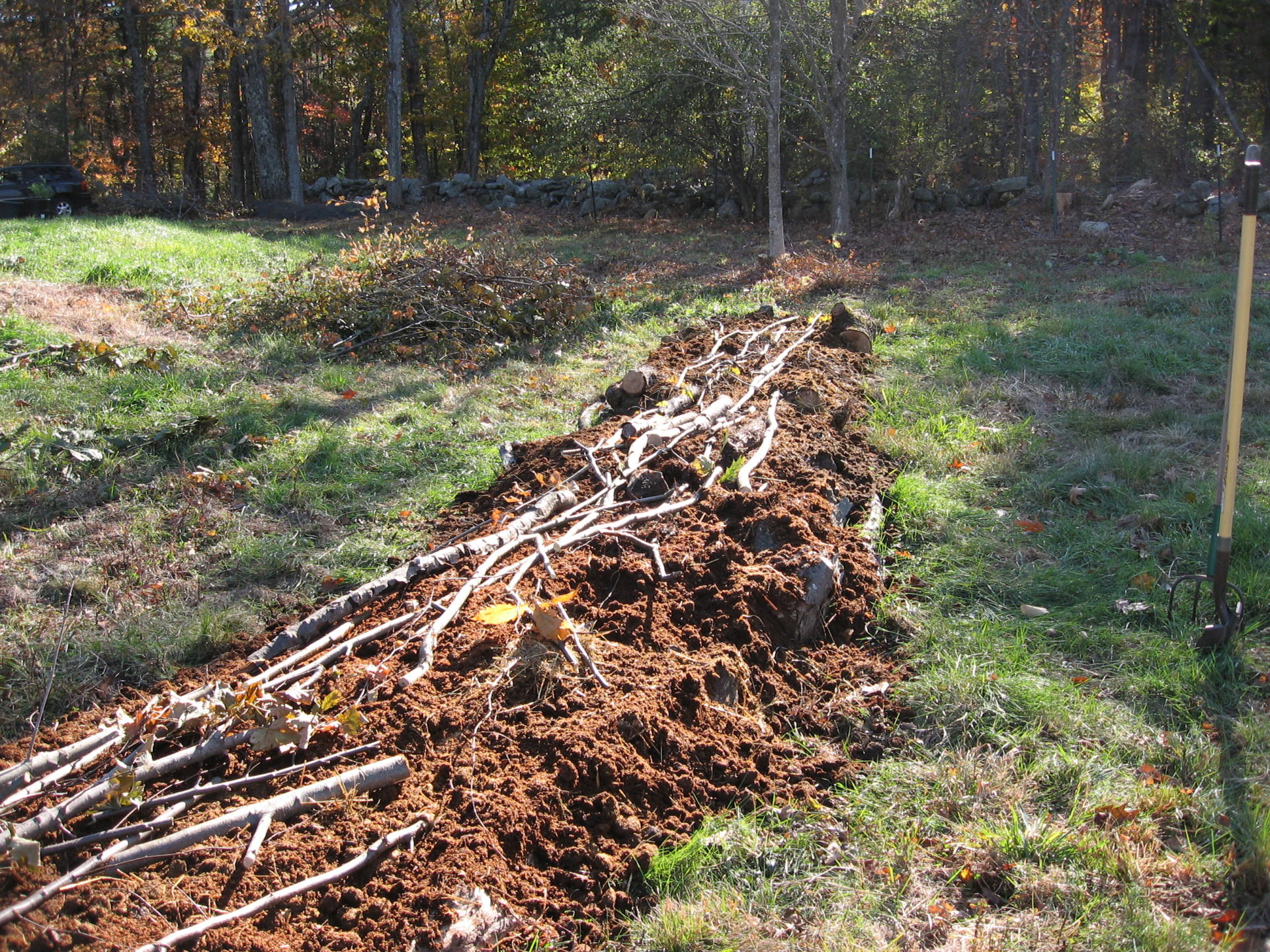
Preparing a planting bed at Woody End Farm in Westminster, MA. Hugelkultur is a German and Eastern European method of gardening where woody material is incorporated into mounded planting beds to take advantage of the nutrients and moisture that the decomposing wood provides.
Nutrient Supply.As saprophytic fungi chemically break down wood, nutrients are released into soluble forms that can be taken up by plant roots and by mycorrhizae. These are the same nutrients in the fertilizers that we apply to our landscapes, such as phosphorus, nitrogen, calcium, and magnesium. By retaining wood in land and allowing it to be converted, we provide a continual source of slowly released nutrients—with fungi doing all the work.
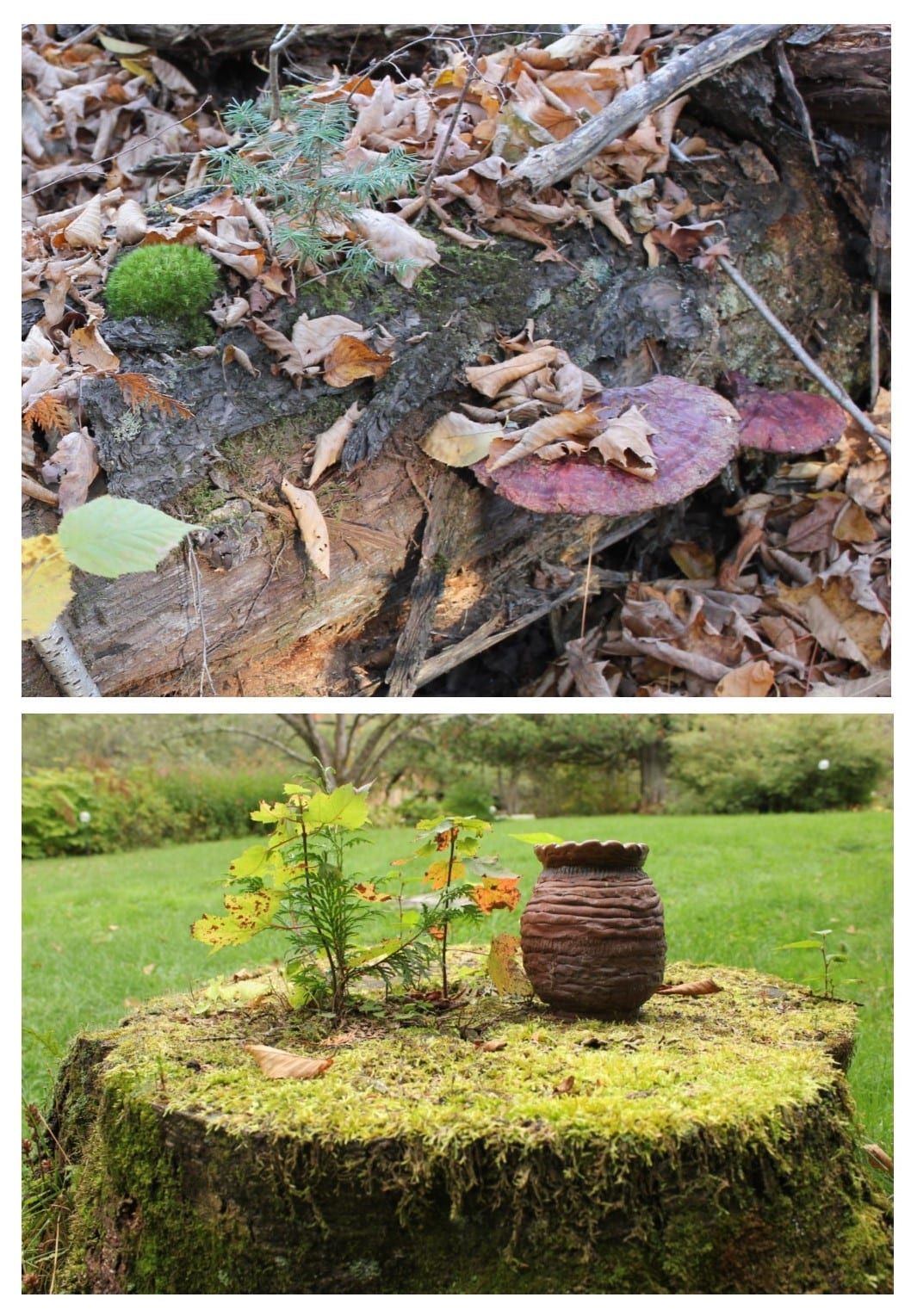
Above: In the forest, decaying logs often serve as “nurse logs” for saplings. As decomposers, such as this hemlock varnish shelf mushroom (Ganoderma tsugae), break down the wood, nutrients are released and made available for uptake by plants. Below: Similarly, in a managed landscape, a spruce stump supports new plant growth and creates a decorative addition to the yard.
Habitat. Dying and dead trees, logs, and stumps provide habitat for a myriad of creatures. As fungi break down the hard cellulose and lignin, wood becomes increasingly accessible to countless insects. Many of these insects, such as beetles, have evolved symbiotic relationships with fungi so that their larvae can consume or tunnel through the tough components of the wood.
While standing, dead and dying trees provide habitat for species that inhabit the wood as well as for any number of species simply passing through. Cavities created by fungi serve as nesting sites for bees and wasps and places for squirrels and chipmunks to stash nuts. Woodpeckers, in particular, depend on the work of fungi. They feed on the insects that colonize the wood, and the decaying wood is easier to excavate for nesting cavities. Once abandoned, woodpecker nests are used by nuthatches, owls, bats, and other wildlife.
When dying or dead trees fall to the earth, new habitats are created. Contact with soil increases moisture and changes temperature and oxygen levels in the wood. Secondary saprophytic fungi that feed on already decayed wood replace the early colonizing fungi, and the hard bracket mushrooms give way to the soft-bodied cap and stalk mushrooms and to puffballs or coral mushrooms. These short-lived, fleshy fungi are an important source of food for slugs, snails, beetles, gnats, squirrels, and chipmunks. Detritivores, such as springtails, ground beetles, and millipedes gain greater access to the increasingly softened wood, further breaking it down and converting it into soil to support new cycles of life.
A More Fungal-Focused Future
Certainly, parasitic fungi can cause problems in the managed landscape. But, often, those problems are due to planting trees in the wrong place and in the wrong environments. And of course, we don’t want rotting trees where they will fall on property or injure people, but it doesn’t mean dying trees and dead wood should have no place in the landscape. The intent of landscaping is not, after all, to produce lumber or fruit (although it could be).
Designing to create more complex systems and selectively managing that vegetation, both living and dead, would allow wood-inhabitants a place in the managed and urbanized landscape. We might then find that our questions on how to create low maintenance, more resilient landscapes have already been answered.
About the Author
Tara Mitchell has been a landscape architect with the Massachusetts Department of Transportation for 19 years. Her focus is on roadside restoration, native seeding, naturalistic landscape design for urban areas, and urban gardening for food and habitat. More recently, she’s been focusing on the realm of fungi and the hidden connections between plants and fungi.
***
Each author appearing herein retains original copyright. Right to reproduce or disseminate all material herein, including to Columbia University Library’s CAUSEWAY Project, is otherwise reserved by ELA. Please contact ELA for permission to reprint.
Mention of products is not intended to constitute endorsement. Opinions expressed in this newsletter article do not necessarily represent those of ELA’s directors, staff, or members.

